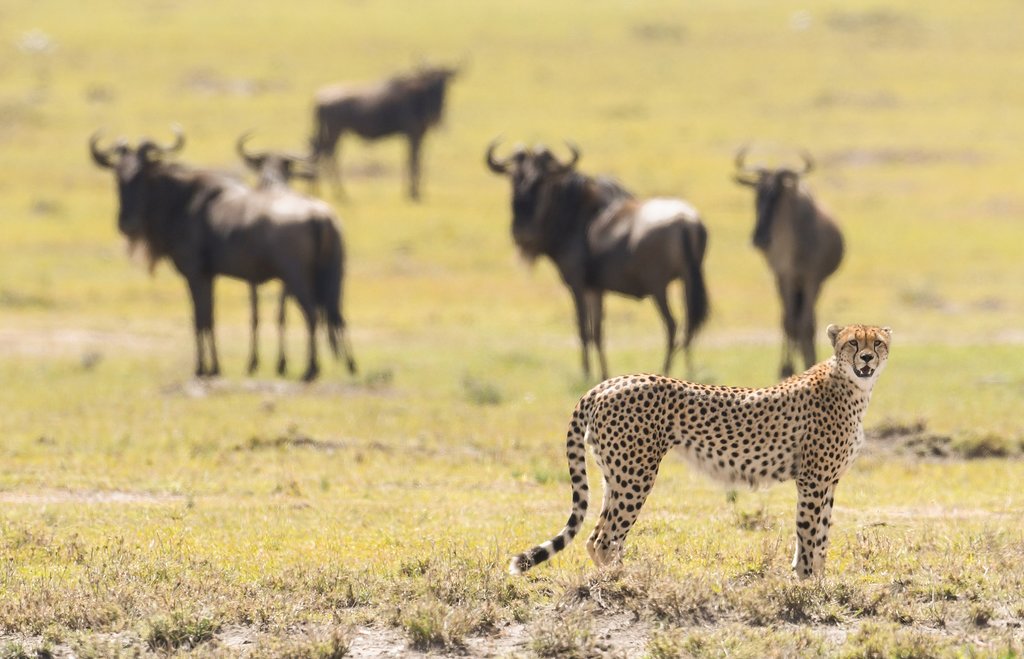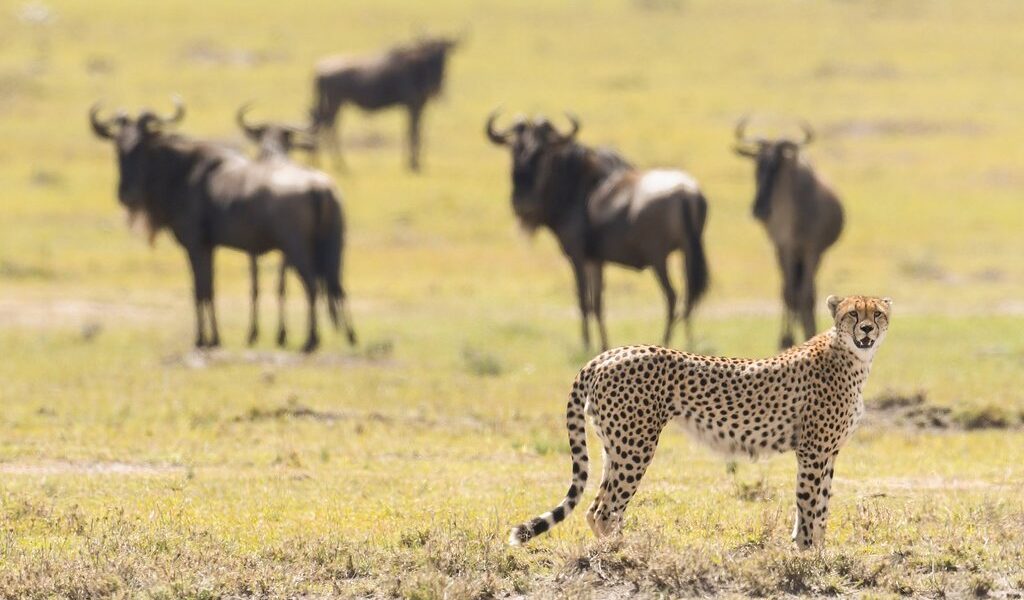
April is a wet, rainy month in Kenya. The coasts are extremely hot and rainstorms are frequent and steady. Meanwhile, wildlife is tougher to spot on safaris due to thick vegetation and lack of animals visiting water sources. The upshot, however, is that it’s a cheap time of year to visit—and there are hardly any tourists. Plus, since rain often only falls in the afternoon, you’ll still have time to enjoy the morning hours.
Weather
April in Kenya is characterized as one of the months with the highest rainfall, truly marking it as the rainy season. The precipitation is frequent and substantial, influencing travel plans and outdoor activities considerably. Simultaneously, April also presents some of the year’s warmer temperatures, especially in the initial weeks of the month and predominantly along the coastal regions. In these coastal areas, daytime temperatures typically fluctuate between a balmy 86 and a sweltering 95°F.
Venturing inland to Nairobi, the climate is somewhat milder, providing a welcome respite from the coastal heat. During the day in Nairobi, average temperatures hover between 77 and 82°F. As evening descends, the temperature experiences a noticeable drop, often reaching a cooler 55°F, making a light jacket or sweater a prudent addition to your packing list. This contrast between daytime warmth and nighttime coolness defines the April weather experience in the capital city.
As the continuous rain characterizes the month, locally referred to as the “green season,” a gradual cooling trend emerges. Toward the end of April, travelers can anticipate lower temperatures than at the beginning of the month. However, it’s important to remember that the rains also bring mosquitos, particularly in the national parks. These insects are abundant and persistent, making effective insect repellent a crucial and absolutely mandatory item for anyone venturing into these areas. Prevention is the best approach, ensuring a more comfortable and enjoyable experience amidst the natural wonders.
Crowds and Costs
One significant advantage of traveling during the rainy season is the reduced number of tourists. The consistent rainfall discourages many visitors, resulting in fewer crowds at popular attractions and destinations. In fact, April offers a unique opportunity to book safaris and enjoy them with far fewer fellow travelers. It’s one of the rare times of the year when you can practically have the safari experience all to yourself. The museums and various tourist sites in the capital city will be less crowded, creating a more intimate and immersive experience for visitors.
Similarly, the beach resorts tend to resemble virtual ghost towns, offering tranquility and space, except during the week of Easter. During Easter week, local residents often take vacations to the coast, leading to a temporary increase in beach crowds. However, outside of this short period, April provides a peaceful and less crowded coastal experience.
Another benefit is that travel-related costs are typically more reasonable during this time. Many hotels offer special “green season” rates, providing discounts and incentives to attract visitors during the off-peak season. Airlines also tend to lower their prices, making it more affordable to travel to Kenya in April. This can significantly reduce overall trip expenses, making it an appealing option for budget-conscious travelers.
Where to Go
Considering the weather conditions in April, Nairobi emerges as a favorable destination. The temperatures are generally cooler than along the coast, offering a more comfortable climate for exploration and activities. Furthermore, the capital city provides numerous indoor options for entertainment and engagement, perfect for those occasional afternoon rain showers.
Restaurants and nightclubs frequently introduce special promotions during this off-season period, aiming to attract both tourists and locals alike. This allows visitors to take advantage of lower prices while enjoying the local culinary scene and nightlife. Reduced lines and smaller crowds make these experiences even more enjoyable.
Safaris remain a viable option in April, although travelers should be prepared for rain and conditions that may be less than ideal. Mosquito activity is elevated, necessitating diligent use of insect repellent. Additionally, roads can be challenging to navigate due to the rainfall. Wildlife viewing dynamics also shift during this time. Elephants, for instance, are less likely to congregate around waterholes as the rain provides sufficient cooling. Other wildlife may be less concentrated in specific areas, making them harder to spot.
The increased vegetation density can also hinder wildlife sightings, making it more difficult to spot cats and other game animals. Some animals may also seek shelter during periods of heavy rain, further impacting visibility. Overall, while safaris are still possible, the amount of wildlife seen may be reduced compared to the drier months.
Despite these challenges, April safaris offer the advantage of lower prices. Typically, the rain is confined to the afternoons, allowing for relatively dry tours in the mornings. The rain also transforms the landscape, creating lush and scenic vistas. It’s important to note, however, that morning temperatures can be quite cool, requiring appropriate clothing. Maasai Mara remains a viable option for a safari, and a trip to Hell’s Gate National Park can also be considered. However, caution is advised at the latter due to the risk of flash flooding. Engaging a reputable guide is highly recommended to ensure safety and navigate the park effectively.
In general, it is recommended to avoid the beaches during April. They tend to be wet, hot, and rainy, limiting opportunities for traditional beach activities and water sports.
What to Do
Nairobi provides a diverse array of activities suitable for an April vacation. In the mornings, before the daily rains commence, consider visiting the unique black rhino sanctuary located in Nairobi National Park, conveniently situated just outside the city limits. In the afternoons, explore indoor attractions such as the Nairobi National Museum, where you can delve into Kenya’s rich history and vibrant culture. The museum also offers shopping and dining options, as well as beautiful botanical gardens to explore. Nairobi boasts a thriving food scene, offering a range of culinary experiences. Indulge in rich Indian biryani at AA Mithaiwalla, or savor delectable Kenyan seafood at Tamarind. For those interested in nightlife, the city is brimming with cocktail lounges, brewpubs, bars, and nightclubs.
For those considering a wildlife safari, Maasai Mara remains a good option in April. The mornings are usually relatively clear, and the roads are generally accessible, even during the rainy season. Beyond its iconic wildebeests, which may be present but not actively migrating, you have the opportunity to observe elephants, zebras, hippos, giraffes, cheetahs, and a wide array of other fascinating animals.
Mount Kenya National Park presents another enticing choice. This expansive park is home to the renowned 17,057-foot Mount Kenya, which can be admired from various vantage points throughout the park. Adventurous travelers may even choose to climb the mountain. The park’s diverse landscape also offers scenic beauty and a wide variety of wildlife.
Events in April
Easter: Kenya observes Easter in early to mid-April, a nationally recognized holiday. Many Kenyans travel to the coast during this period, leading to increased crowds on the beaches. This influx of visitors contrasts with the overall trend in April, which typically sees smaller crowds. In the city, churches hold special services and masses, and public celebrations are often organized.
Traveling to Kenya in April? Check out this great itinerary
Ultimate Kenya: Mt. Kenya Trek & Maasai Mara Safari – 12 Days: This meticulously crafted 12-day itinerary presents a spectacular fusion of national parks and urban attractions, making it an ideal choice for April travel due to its strategic avoidance of destinations prone to excessive rainfall during this period. Your journey begins in Nairobi, where you’ll embark on sightseeing excursions and explore notable tourist attractions before venturing to Mount Kenya National Park. There, you’ll undertake a captivating three-day trek to the majestic summit of Mount Kenya. The concluding five days will be dedicated to exploring Lake Naivasha, Maji Moto Maasai Cultural Camp, and the world-renowned Maasai Mara.
B-1527

